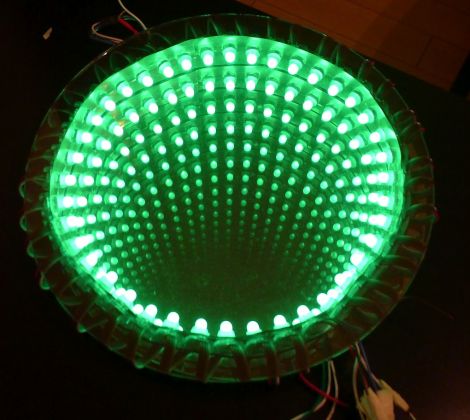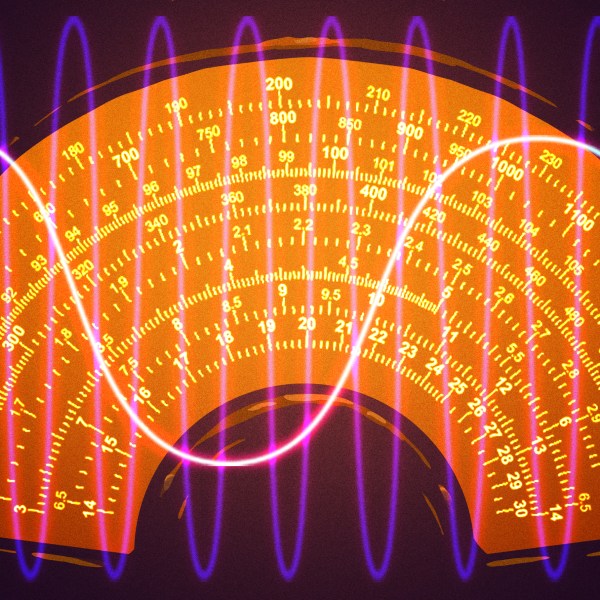
[acorv] recently sent us a link to a cool, interactive infinity mirror (Translation) he built. He was originally a bit gun-shy about sending the project our way, but our recent Reddit AMA inspired [acorv] to submit it via our tip line, and we’re glad he did.
Having been lucky enough to score $100 of gear from Sparkfun’s 2012 Free Day, he picked up a pair of addressable LED strips and a Teensy++. He built an LED ring from reflective foil, sandwiching the strips between a mirror and a piece of mirror glass. The resulting infinity mirror looked nice enough, but [acorv] wanted to make the static display a bit more interesting.
He added an IR receiver and ultrasonic rangefinder to the mirror’s frame, allowing him to both control the display remotely and detect when people were standing nearby. As you can see in the video below, [acorv] can change the patterns on a whim, and the mirror speeds up the display when someone stops to take a closer look.
[vimeo http://vimeo.com/45364766 w=470]
















Very cool! Está to wapo, acorv!
But not infinite, just a 13 times repetition. Why?
It would be infinite if both mirrors either side of the LEDs reflected 100% light, but then we wouldn’t be able to see the effect, so one of the mirrors has to let some light through for us to see it and so some of the light escapes and we get the effect of the reflected LEDs getting dimmer in the distance.
Gracias!
Haku is correct. I believe the effect could be improved with better quality glass and mirror.
Thanks [acorv], Hackaday and Reddit. Very, very cool build.
nice build; now turn it into a clock and hang it on the wall.
My thought exactly. Maybe merge the LED control theory of Evil Mad Scientist’s bulb-dial clock with this display for a truly epic clock.
Very cool project! It sent my mind back to Stargate SG-1… which then got me thinking that an even more interesting effect could be produced if 4 servos were used to slightly tilt one of the mirrors on both the x and coordinates.
Doing that, it could be made to appear as the destination to “infinity” was located through a infinitely long, twisting, turning, winding wormhole (which, I suppose, could only exist in an infinite number of interacting universes).
Thanks! A friend actually suggested the servo idea when I was building it. I made a few ‘manual tests’ (moving the mirror by hand) and the effect is very much like you describe it :)
How about adressing every single reflection using some speed of light math? I guess you can’t be fast enough to catch light using microcontroller, but maybe you can achieve such time offset by controlling LEDs trough different lengths of wire (or low-inductance coils). Is it possible?
LED’s themselves work too slowly.
Maybe i2c controller… Still can drive them directly.
Fantastic Build. Perfect example of electronics and art combining.
+1 for nice wire coiling
+1 for reactive sensors.
Well done. WOOT.
So he put a mirror at the back and a semipermeable glass on the front???
Did I get that right?
Yes. Though I don’t know if semipermeable is what it is called….semi-reflective?
If you want to make your own infinity mirror it’s very easy to do (it’s on my list of “things to make one day”).
Silver window tinting film is a cheap way of making your own one-way mirror for the side you look through by putting it on some ordinary glass.
On second look. The LED housing does not appear to be circular…that’s the only potential flaw I see.
Buena esa acorv!!!
Built one by scraping away the back of the 2nd mirror with sandpaper. No foil required…
Nice one, acorv !!!
My God-
It’s full of LEDs…
One way to make it work better for the light effect and work better as a mirror is to have an outer mirrorized ring on the front glass with the center clear.
Even better is to have a ring shaped mirror with a hole so the back mirror’s center has nothing in front of it.
A relatively inexpensive way to make custom shaped mirror areas on clear substrates (glass, lexan, other clear plastics) is Spaz Stix Ultimate Mirror Chrome paint. (Costs less if you buy from a distributor instead of direct from the manufacturer.)
I’ve used this paint a lot and it “does exactly what it says on the tin”. If the surface you spray it on is mirror smooth, this paint makes it into a reflective mirror.
It works on the front or back side so it can be used to make front surface or back surface mirrors. Spaz Stix also has special clear overcoat and white and black back coat paints which won’t damage the mirror paint.
Depending on how much mirror paint you apply, the back coat paints can alter the look of the mirror, with black giving it more of a polished stainless steel, chromium or nickel effect.
It sounds like its giving off some interference… kinda weird for just some LEDs. Also, I noticed brightness affects the number of reflections so could you get a spiral going? That would be awesome.
Never mind the interference….ultrasonics…duh
Great Build !!
This is by far the coolest looking infinity mirror I have seen anywhere. It is a complete breakaway from all other infinity mirrors. Your design pushes the envelope, Remarkable. I am at this time attempting to make my first infinity mirror, but not really sure how to go about starting one. My desire is to end up with an infinity mirror 24 inches in diameter, minus the frame width. Totally love your creation and would enormously appreciate a shove in the right direction as far as materials, cost, and any helpful information to achieving a mirror as impressive as your. Thank you.
If we have stronger light we have then more number of reflections,,is this the trick??
Reply
if one can find a one-way mirror that allows little light to pass through, will the effect be better?